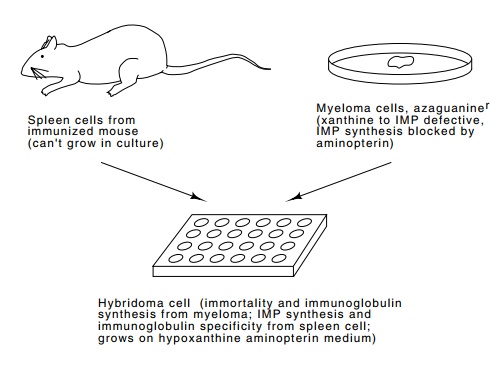Chapter: Genetics and Molecular Biology: Generating Genetic Diversity: Antibodies
Myelomas and Monoclonal Antibodies
Myelomas and Monoclonal Antibodies
The tremendous diversity in antibody specificities
present in the serum of an animal precludes any simple study of homogeneous
antibody. Although purifications based on binding to an antigen might be at-tempted
for obtaining antibody with one specificity, the resultant anti-bodies would
still be highly heterogeneous, for many different antibodies normally are
induced by a single antigen. Even a molecule as simple as phosphocholine can
induce synthesis of hundreds of different antibodies. Instead of pursuing the
purification of a single antibody out of the thousands that are induced,
researchers have made use of a cancer of the immune system to obtain
homogeneous antibod-ies.
A lymphocyte with unregulated cell division generates a cancer called myeloma. The serum of patients with myeloma contains high concen-trations of one single antibody. Myelomas can also be induced in mice, and the cancerous cells can be transferred from mouse to mouse. The ascites fluid collected from such mice is a solution of almost pure, homogeneous antibody. A particular myeloma can be indefinitely propagated, and its corresponding antibody can be easily purified and studied.
The major problem with the use of myelomas is that
their antigens are unknown. Of course, it is possible to screen hundreds of
myeloma antibodies against thousands of potential antigens to find a molecule
the antibodies bind to, but this does not prove to be highly successful. It
would be ideal to be able to induce a myeloma for any desired antigen. This can
be done. Milstein and Kohler discovered that the immortality of a myeloma cell
line can be combined with the selectable antigen specificity of antibodies that
are obtained from B cells of immunized animals. If a variant myeloma line has
been used that itself does not produce antibody, the result of the fusion is a
cell line that synthesizes a single type of antibody. This has the desired
binding specificity. The cell line can be grown in vitro or injected into mice, giving them myeloma but providing a
convenient source of large quantities of their antibody product. The antibodies
produced by these means are called monoclonal because they derive from a single
cell or clone.

Figure 20.2 Scheme for the production of cell lines synthesizing monoclonalantibodies. Neither of the parental cell types can grow in the hypoxanthine aminopterin medium.
Mouse cell lines synthesizing monoclonal antibodies
are isolated by fusing myeloma cells with lymphocytes extracted from the spleen
of a mouse about five days after its immunization with the desired antigen
(Fig. 20.2). The cell fusion is accomplished merely by mixing the two cell
types in the presence of polyethylene glycol.
This agent induces fusion of the cell membranes; after an interval of
unstable growth in which a number of chromosomes are lost, relatively stable
chromosome numbers, called karyotypes, are established in the population. To
re-duce the background deriving from growth of unfused parental cell types, a
genetic selection against both of the parental cell types is used so that only
a fusion product can grow. The fused cells are then diluted to a concentration
of a few cells per well of a culture tray, and after they have had time to grow
and secrete antibody to the growth medium, the individual cultures from the
wells are screened for the presence of antibody with the desired specificity.
Monoclonal antibodies find wide use in diagnostic
and therapeutic medicine and in many types of basic research. In addition to
providing an almost limitless supply of antibody with unchanging
characteristics, monoclonal technology permits antibodies to be made against
materials that cannot be completely purified. For example, monoclonal
antibod-ies can be made against the cell walls of neurons from an animal. The
neurons are dissected out, cell walls isolated and injected into a mouse, and
the fusion of spleen cells to the myeloma line performed. Even unfractionated
brain could be used for the initial injections. The anti-bodies synthesized by
the fused cells can be screened for desired properties. Some of the resulting
monoclonal antibodies have been found to bind to all cells, some bind only to
neurons, and others bind to just a few neurons. Presumably neurons of the
latter class are closely related to one another in lineage or function.
Related Topics